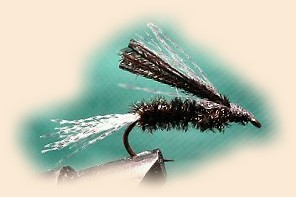Someone may have already invented this pattern, but I
came up with it while experimenting with Krystal Flash
and dubbed it the Pan-Handler. I've used this pattern
for a couple of years and have taken many bluegills on
it. I decided to try it on crappies this winter and it
was clearly a great fly for them as well. I usually
forget to add weight to the hook shank and the photos
here are no exception. It's best to add weight to catch
the crappies, but the gills won't care in the least. I
attribute the fly's success to its colors and reflectivity.
Materials for Pan-Handler:
Hook: Wet nymph hook (Mustad 9671 size 10 shown).
Thread: 3/0, Black.
Weight: Several wraps of lead wire, if legal.
Body: 4-5 strands of Peacock herl.
Tail, Wing Case and Wing: 6-8 strands of Pearl
Krystal Flash Wing Material.
Note: Pearl Krystal Flash is chartreuse when it's wet
and everyone knows crappies like that color.
Instructions - Pan-Handler:

1. Start thread on the hook and wrap back to the bend.
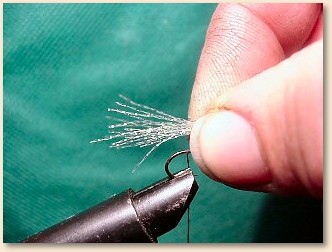
2. Select 6-8 strands of Krystal Flash at least three
times the length of the hook shank. Tie one hook shank
length of Flash over the hook bend for the tail.
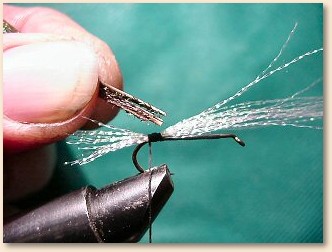
3. Tie the Peacock herl onto the hook in front of the tail.
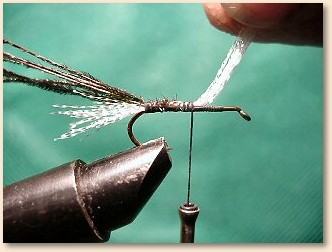
4. Wrap the thread over the flash to the center of
the hook shank.
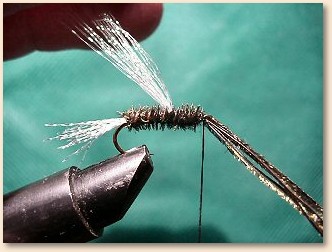
5. Wrap the body to the center of the hook shank.
Lift the remaining Flash material up and wrap the
thread forward to the eye. Then wrap the body to
just behind the eye and secure with a couple of
thread wraps.
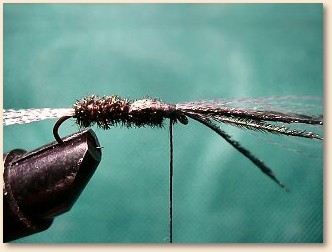
6. Pull the remaining Flash over the body to form
a wing case and secure it just behind the eye.
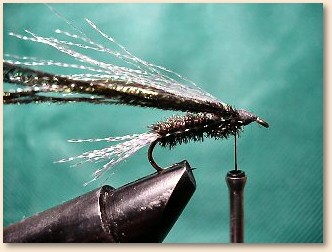
7. Pull the remaining Flash and Peacock back over
the body to form a wing making sure the herl lays
in with the Flash. Tie a tapered head at the eye
and whip finish.
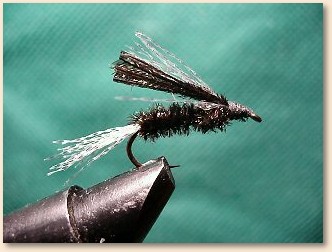
8. Trim the wing just past the hook bend. Apply glue
to the tapered head to finish.
How to Fish the Pan-Handler:
When fishing for bluegills I cast the fly near the
weeds and wait several seconds for the fly to drop a
few inches below the surface. I give the fly a few
small tugs and then stop, wait a few seconds, then
tug again. Usually you'll only tug the fly the first
time before a gill grabs it. Retrieve and repeat as
needed.
When fishing crappies I use the weighted version. I
cast into the deepest part of a channel and leave the
fly to sink for several minutes. Then I begin to slowly
retrieve the fly in about 6-8" strips by raising the
rod tip slightly. Drop the rod tip and pull in the slack
line, wait a bit for the fly to settle and then raise the
rod tip again. I've found the crappies are very subtle
when they take this fly and so they're difficult to detect.
That's why I use the rod tip technique; I can watch for
tension in the line and the hook is already beginning to
set itself this way. If there's a fish on then I continue
to raise the rod tip and strip set the hook.
My last trip out I intentionally went after crappies. I
caught over a dozen crappies on this fly in a couple of
hours and took six of them home for dinner. One bit of
information that helped me hook the crappies was that
they feed up. This means they're not likely to take the
fly while it's dropping, but when you're raising your rod
tip the fly rises and the crappie will likely take it then.
Good Luck and Enjoy Pan-Handling! ~ Tim
About Tim Lunceford:
Tim spent nine years in the U.S. Air Force, with three years
working on the F-117 A Stealth Fighter, and is a veteran
of Desert Storm. He lives and fishes from his kayak around
Kansas City, Missouri. He's been married 23 years and is
the father of four kids - three have Fragile-X syndrome, a
genetic disorder that causes retardation and autism.
He now works as a Heat and Frost Insulator for Local
Union #27 in K.C and teaches Youth Sunday School class.
Tim also enjoys web design, graphics and digital image
manipulation, watercolor painting, playing guitar, and
writes contemporary Christian songs, none of which have
been recorded,...yet.

